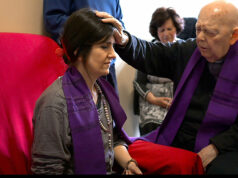
I’ve always loved St. Peter. The first pope, the rock, the enthusiastic leader, the man who would jump first and think later, who would deny and repent, who told Jesus three times that he loved him, only to later deny him.
It is probably St. Peter’s well-publicized failures that make him such a good spiritual guide. We see that even if we stumble through faith like Peter, it is possible to become close to God and it is possible to affirm our faith.
According to Father Michael Mullins, author of “The Gospel of John: A Commentary,” we would know little about the night trial of Jesus with the high priest if it were not for the episode involving St. Peter’s renunciation, which came just hours after he had valiantly declared, “I will lay down my life for you,” (Jn 13:37).
“In the first days of the church, Peter’s denial became awfully important for Christians because of the persecutions, like the frightful persecution by Nero. A lot of people may very well have denied the faith and they were in danger of despairing so Peter’s story of denial and then reinstatement would have been important for them,” Father Mullins said.
Peter guides us through his story of faith in Jesus and Jesus’ reciprocation with a boundless trust in his chosen instrument. Peter met Jesus through his brother Andrew. Moved by Peter’s answer when he asks him who he is, “You are the Messiah, the Son of the living God” (Mt 16:16), Jesus calls him “blessed” and reveals to Peter his mission: “You are Peter, and upon this rock I will build my church” (Mt 16:18).
Peter’s strong faith and frailty are contrasted when he sees Jesus walk on water. Jesus bids him to join him. Immediately Peter steps out of the boat in faith but takes fright when he starts to sink. “He discovers his own vulnerability,” says Father Mullins. Jesus catches him, holds him and says, “Why did you doubt?”
Jesus knows Peter as he is. He knows he will deny him. At the Last Supper he tells Peter he has prayed “that your own faith may not fail,” (Lk 22:32).
His trust in Peter plays out movingly in the Gospels.
The hearts of the disciples of Emmaus burned as Jesus explained the Scriptures to them. After Pentecost, Peter constantly does the same.
“Peter is looking at the history of the people of God and seeing the death, resurrection and glorification of Christ and the outpouring of the spirit that God has brought about as the fulfilment of the whole historical process,” says Father Mullins. “He opens the Scriptures to people and is a spiritual guide.”
At the same time, Peter keeps before him at all times the figure of Christ’s infinite love. “Let your love for one another be intense, because love covers a multitude of sins,” he writes, putting into words the love and trust he himself experienced from Jesus.
— By Susan Gately
Gately is a freelance writer from Dublin, Ireland.







